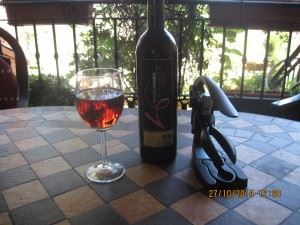 When we went to Lemon Tree Road Market on Sunday, we noticed that one of the stalls was selling wines. That’s always of interest to the residents of Piddock Place, but what was particularly interesting was that one of the wines was marked up as ‘The best rosado in Spain,’ and it was priced at just 5€. Now, I love rose wine almost as much as I love cava, so I had to have some of that. Tony was a bit off about paying 5€ for a bottle of rose – mainly because he doesn’t like it. However, I told him I had to have it, because it would make a really interesting post for the blog. That’s my excuse and I’m sticking to it!
When we went to Lemon Tree Road Market on Sunday, we noticed that one of the stalls was selling wines. That’s always of interest to the residents of Piddock Place, but what was particularly interesting was that one of the wines was marked up as ‘The best rosado in Spain,’ and it was priced at just 5€. Now, I love rose wine almost as much as I love cava, so I had to have some of that. Tony was a bit off about paying 5€ for a bottle of rose – mainly because he doesn’t like it. However, I told him I had to have it, because it would make a really interesting post for the blog. That’s my excuse and I’m sticking to it!
My friend Angela is over from the UK for a few days to sort out a minor crisis, and she’s been enjoying a few glasses of wine with me at night to unwind. Up to now, we’ve unwound to the tune of about 6 or 7 bottles over three evenings, so when she came around for supper last night, I suggested we open ‘The best rosado in Spain’ before we became too unwound to know or care what we were drinking.
So then, what were we drinking? Pago del Vicario’s Petit Verdot Rosado, from Castile- La Mancha. As an interesting by-the-way, the estate at Casas near Cuidad Real has a hotel, so if you want a serious tasting session, you can book into the hotel and sleep it off.
Our bottle was the 2013 vintage, and the first thing we noticed was the 15% alcohol by volume. So we thought we were in for more of a fortified wine than a light crisp rose. And we were right, although it’s nothing like a port or sherry. The colour is amazing – dark pink, almost red, with a satin sheen to it that made it look really good in the glass.
When it came to the nose, the main thing that hit us was the aroma of red berries – strawberries and raspberries in particular, combined with a slightly creamy smell. All in all, it seemed more like liquid food than drink, and that might put some people off, especially those used to a lighter Spanish rose. However, a wine has to be really bad to deter us, so it was bottoms up time.
The fruity flavours of the nose came through on the taste buds – it was almost like drinking a fruit punch, but with that kick that you get from a high alcohol content. It was slightly sweet, but not overly sweet, so you couldn’t really categorise it as a dessert wine. The robust flavour went well with the chilli con carne I served up for supper, but it would be rather overpowering as an accompaniment for fish and poultry. It’s definitely a red meat wine.
Did we enjoy it? Most definitely. Would I buy it again? Double definitely. Is it really ‘The best rosado in Spain?’ No, because it isn’t really a rosado you can compare with others on a like for like basis. However, if you like a bit of oomph in your wine, this is one for the rack. It’s a wine to savour in small doses, rather than a good old session with friends. Vino collapso it isn’t – it’s too rich and full bodied to knock back in industrial quantities. Apart from that, the colour hints at a heavy dose of congeners, so you might wake up with the Hangover from Hell if you’re too enthusiastic with this one. Just saying!
I have a brand new, shiny website - Sandra In Spain! Take a look here, and tell me what you think.